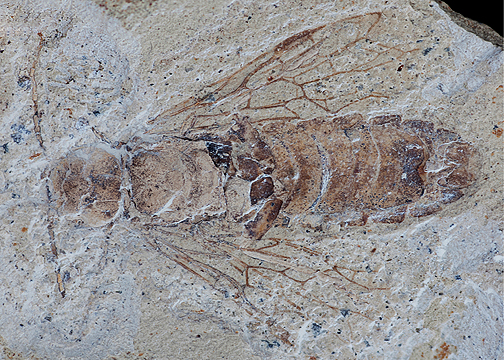Abstract
The position of the enigmatic Oligocene pamphiliid genus and species Tapholyda caplani (Cockerell, 1933) is revised based on new specimens from the late Oligocene of the Creede Formation (Colorado, USA). The study of the wing venation and body characters indicate affinities with the fossil subfamily Juralydinae. The species is transferred to the latter accordingly. We revise the diagnoses of the Juralydinae and Tapholyda caplani. We designate a lectotype for the species and provide an interpretative drawing of its forewing venation. The placement of Tapholyda caplani in the Juralydinae extends the temporal range of the subfamily to the Oligocene.
References
Archibald, S.B. & Rasnitsyn, A.P. (2016) New early Eocene Siricomorpha (Hymenoptera: Symphyta: Pamphiliidae, Siricidae, Cephidae) from the Okanagan Highlands, western North America. Canadian Entomologist, 148, 209–228. https://doi.org/10.4039/tce.2015.55
Axelrod, D.I. (1987) The late Oligocene Creede flora, Colorado. University of California Publications in Geological Sciences, 130, 1–235.
Beneš, K. (1968) A new genus of Pamphiliidae from East Asia. Acta Entomologica Bohemoslovaca, 65, 458–463.
Benson, R.B. (1945) Classification of the Pamphiliidae (Symphyta). Proceedings of the Royal Entomological Society of London, (B), 14, 25–33. https://doi.org/10.1111/j.1365-3113.1945.tb00012.x
Cockerell, T.D.A. (1933) A fossil sawfly from the Miocene shales near Creede (Colorado). Bulletin of the Brooklyn Entomological Society, 28, 186–187.
Goulet, H. & Huber, J. T. (1993) Hymenoptera of the world: An identification guide to families. Agriculture Canada, Ottawa, Ontario, 1–680.
Kemal, M. & Koçak, A.Ö. (2013) Pseudocephaleia praeteritorum (Semenov) a new record for Turkey (Hymenoptera, Pamphiliidae). Cesa News, 90, 15–16.
Larsen, D. (2000) Upper Eocene and Oligocene lacustrine deposits of the Southwestern United States, with emphasis on the Creede and Florissant Formations. In: Gierlowski-Kordesch, E.H. & Kelts, K.R. (Eds), Lake basins through space and time. American Association of Petroleum Geologists, Studies in Geology, Special Volumes, 46, 425–438. https://doi.org/10.1306/St46706C39
Larsen, D. & Crossey, L.J. (1996) Depositional environments and paleolimnology of an ancient caldera lake: Oligocene Creede Formation, Colorado. Geological Society of America Bulletin, 108, 526–544. https://doi.org/10.1130/0016-7606(1996)108<0526:DEAPOA>2.3.CO;2
Nel, A. (2004) New and poorly known Cenozoic sawflies of France (Hymenoptera: Tenthredinoidea, Pamphilioidea). Deutsche Entomologische Zeitschrift, 51, 253–269. https://doi.org/10.1002/mmnd.20040510208
Niu, G.Y., Korkmaz, E.M., Doðan, Ö., Zhang, Y.Y., Aydemir, M.N., Budak, M., Du, S.Y., Baþýbüyük, H.H. & Wei, M.C. (2019) The first mitogenomes of the superfamily Pamphilioidea (Hymenoptera: Symphyta): mitogenome architecture and phylogenetic inference. International Journal of Biological Macromolecules, 124, 185–199. https://doi.org/10.1016/j.ijbiomac.2018.11.129
Peñalver-Molla, E. & Arillo, A. (2002) Primer registro fósil del género Acantholyda (Insecta: Hymenoptera: Pamphiliidae), Mioceno inferior de Ribesalbes (España). Revista Española de Paleontologia, 17, 73–81.
Rasnitsyn, A.P. (1977) New Hymenoptera from the Jurassic and Cretaceous of Asia. Paleontological Journal, 11, 349–357.
Rasnitsyn, A.P. (1983) Fossil Hymenoptera of the superfamily Pamphilioidea. Paleontological Journal, 17, 56–70.
Riou, B. (1999) Descriptions de quelques insectes fossiles du Miocène supérieur de la Montagne d’Andance (Ardèche, France). Travaux de l’Ecole Pratique des Hautes Etudes, Biologie et Evolution des Insectes, 11–12, 123–133.
Rohwer, S.A. (1908a) On the Tenthredinoidea from the Florissant shales. Bulletin of the American Museum of Natural History, 24, 521–530. https://hdl.handle.net/2246/1440
Rohwer, S.A. (1908b) The Tertiary Tenthredinoidea of the expedition of 1908 to Florissant. Bulletin of the American Museum of Natural History, 24, 591–595. https://hdl.handle.net/2246/1721
Scudder, S.H. (1892) Some insects of special interest from Florissant, Colorado and other points of the Tertiaries of Colorado and Utah. Bulletin of the United States Geological Survey, 93, 9–31.
Shinohara, A. (1985) The sawfly genus Onycholyda (Hymenoptera: Pamphiliidae) of Japan I. Kontyû, 53, 346–359.
Shinohara, A. (2002) Systematics of the leaf-rolling or web-spinning sawfly subfamily Pamphiliinae: a preliminary overview. In: Viitasaari, M. (Ed.), Sawflies (Hymenoptera, Symphyta) 1. A review of the suborder, the Western Palaearctic taxa of Xyeloidea and Pamphilioidea. Tremex, 1, 359–438.
Taeger, A., Blank, S.M. & Liston, A.D. (2010) World catalog of Symphyta (Hymenoptera). Zootaxa, 2580 (1), 1–1064. https://doi.org/10.11646/zootaxa.2580.1.1
Takeuchi, K. (1938) A systematic study of the suborder Symphyta of the Japanese Empire. 1. Tenthredo, 2, 173–221.
Van Achterberg, C. & Van Aartsen, B. (1986) The European Pamphiliidae (Hymenoptera: Symphyta), with special reference to the Netherlands (Hymenoptera). Zoologische Verhandelingen, 234: 1–98.
Wang, M., Shih, C.K., Ren, D. & Rasnitsyn, A.P. (2014) A new fossil genus in Pamphiliidae (Hymenoptera) from China. Alcheringa, 38, 391–397. https://doi.org/10.1080/03115518.2014.884366
Wang, M., Rasnitsyn, A.P., Li, H., Shih, C.K., Sharkey, M.J. & Ren, D. (2016) Phylogenetic analyses elucidate the inter-relationships of Pamphilioidea (Hymenoptera, Symphyta). Cladistics, 32, 239–260. https://doi.org/10.1111/cla.12129
Wang, M., Rasnitsyn, A.P., Yang, Z.Q., Shih, C.K., Wang, H.B. & Ren, D. (2017) Mirolydidae, a new family of Jurassic pamphilioid sawfly (Hymenoptera) highlighting mosaic evolution of lower Hymenoptera. Scientific Reports, 7, 1–9. https://doi.org/10.1038/srep43944
Wolfe, J.A. & Schorn, H.R. (1990) Taxonomic revision of the Spermatopsida of the Oligocene Creede flora, southern Colorado. United States Geological Survey Bulletin, 1923, 1–40. https://doi.org/10.3133/ofr89433
Zhelokhovtsev, A.N. & Rasnitsyn, A.P. (1972) On some Tertiary sawflies (Hymenoptera: Symphyta) from Colorado. Psyche, 79, 315–327. https://doi.org/10.1155/1972/63630
Zirngiebl, L. (1937) Neue oder wenig bekannte Tenthredinoiden (Hym.). aus dem Naturhistorischen Museum in Wien. Festschrift zum 60. Geburtstage von Professor Dr. Embrik Strand, vol. 3, Riga. pp. 335–350.


